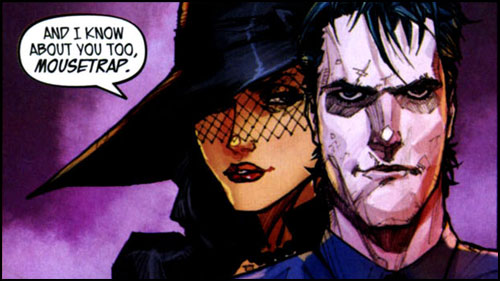When I first saw a piece of cover art for Madame Mirage, I thought is was some kind of Carmen Sandiego bit. Brunette with a wide-brimmed hat, champagne flute in hand, surrounded by tuxedo-clad assailants. How will Carmen get out of this predicament? I was wrong, of course. The two have little in common save for some thrilling headgear.
Produced by Top Cow Productions, generally known for bringing us Witchblade and comic-book adaptations of Gatchaman and Tomb Raider, Madame Mirage is a tale of treachery and revenge. Set in a near-future where technology led to the rise of heroes and villains with superhuman powers, this series uses a now-familiar premise borrowed from The Watchmen, Powers, The Incredibles, and the Nightmare of Futures Past in that there is a population of former super-heroes and super-villains whose operations have been banned. Some supers turned themselves in and have presumably been put into protective custody, many resisted and were forced into captivity, some went to ground. Madame Mirage uses her powers of illusion in a crusade to bring down a criminal organization that traded in their tights and capes for suits and ties.
The artwork, by Kenneth Rocafort, is an interesting blend of highly-stylized character designs and ink work that creates the impression of details through the use of coloring that gives more texture than precision. In several places, a key character on the page is little more than a doodle of ink lines, but the color work gives a richness to the frame as a whole. It reminds me of some of the older Eclipse trading cards and a Paranoia comic that came out ages ago, when airbrushed art was briefly in vogue. Madame Mirage recalls that brief fad without clinging so tightly to some high-falutin artistic conceit.
The plot itself suffers from a heavy-handed Mary Sue syndrome, with the protagonist outsmarting and outmaneuvering and outclassing her opponents at each turn, with even the cliffhangers working into a pre-arranged plan. Once the main character has so thoroughly demonstrated her superiority over all opposition, it gets harder and harder for me to maintain interest; harrowing predicaments fade away. The edge-of-the-seat anticipation is replaced by a disinterested curiosity as to the precise manner in which the bad guys will trip all over themselves and be duped (again) by some ingenious web of deceit. This is a problem I’ve run into with Superman, the Silver Surfer, and most Robert Heinlein books.
The first plot arc is about to wind down with issue 6, after which we’ll see if the series has any real staying power. If the cliffhanger ending to issue 5 is handled properly, Madame Mirage will likely end up on my subscription list for a while to come. If it continues on its current track, it will have amounted to little more than a trashy little pile of eye-candy at the back of a longbox under my stairs.
